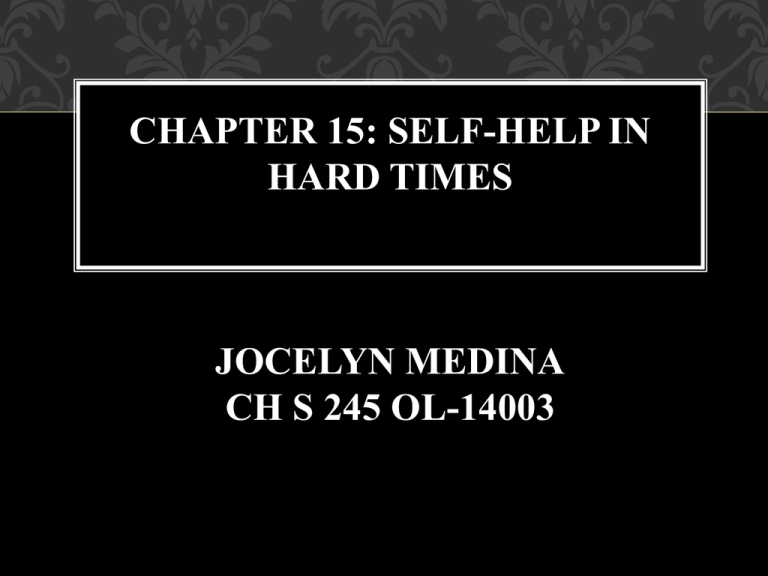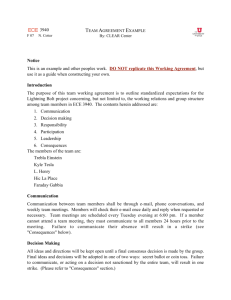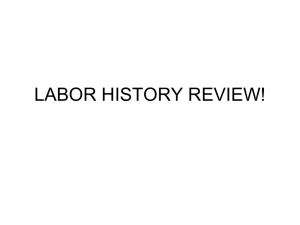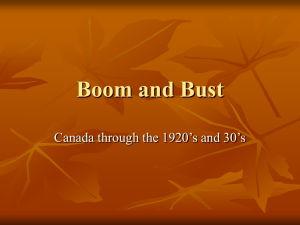Chapter 15: Self-Help in hard times JOCELYN
advertisement

CHAPTER 15: SELF-HELP IN HARD TIMES JOCELYN MEDINA CH S 245 OL-14003 IWW STRIKE • I.W.W was an international revolutionary industrial labor organization formed in 1905 • For five days, Seattle, Washington was in a stop after a walkout of 100,000 working people • There were 35,000 shipyard striking for a wage increase • The strike began on February 6, 1919 at 10:00 a.m. • In some cases, people have been fired for supporting this union THE PROCESS • During the strike, the President of Seattle was imprisoned and tortured because he opposed to the draft. • The city was shut down and all services were under the workers control • Strikers paid 25 cents for their everyday meal • In order to keep peace during the strikes, there was an organization called “Labor War Veteran’s Guard” • No weapons or force were allowed • This caused for crime in Seattle to decrease • The strike ended after five days due to difficulties that were occurring from to the shut down of the city • Although the strike was peaceful, there were raids and arrest after. WESTERN PENNSYLVANIA IN 1919 • In Western Pennsylvania, there were many immigrants of different nationalities working in steel mills for twelve hours a day, six days a week under severe hot weather • On September 1919, 250,000 men went on strike • The department of justice gathered up alien workers to hold them for deportation • The steel corporation hired Sherman Service Inc. to break up the strike • Bad feelings were purposely caused between the Italians and the Serbians • Serbians were told that Italians were returning to work in order for Serbians to return before getting their jobs taken away • More than 30 thousand black men were used as strikebreakers • The number of workers in the strike began decreasing • Workers slowly returned to work, and the National Committee called it off ten weeks later BEGINNING OF 1920’S • At the start of the 1920’s, the I.W.W no longer existed • The strikes had been beaten down and the economy was in a good position that was preventing mass rebellion to occur • The congress put an end to immigrants moving into the cities • There was a limit set for the people that countries could send (Ex: 100 for China, Bulgaria, and Palestine; 34,007 for England and North Ireland; 3,845 for Italy) • Ku Klux Klan revived, spreading to the North and gaining more members causing more violence and hatred • Marcus Garvey had hope for black unity and survival, preaching for black pride and racial separation • Wages for workers began to rise and farmers were making a good amount of money 1920’S • There were about 25,000 workers being killed yearly and 100,000 disabled • People in New York were living in tenements • The rich were in control, pushing to poor into the background and not sharing information regarding them • Fiorello La Guardia was a congressman who spoke for the poor • He visited a poor district in New York and was surprised by the conditions the poor people were living in • The conditions of poverty and the struggles of the workers were not being shown in the news of prosperity • Although women were given the right to vote, only middle-class and upper-class women were allowed to do so THE GREAT DEPRESSION OF THE UNITED STATES • The start of the Great Depression was when the stock market crashed in 1929 • The capitalist system was a system that was unstable, unpredictable, and did not see the human needs • The results of that were people in depression and a crisis • It caused widespread unemployment and wage cuts • Many banks and businesses had to close down due to the lack of money coming in • Towns and cities were not earning much through taxes since there were fewer people working • The people responsible for the economy did not want to recognize what was occurring • On March 1931, Henry Ford stated that America was in a crisis because men would not work the jobs that were available for them THE SPIRIT OF REBELLION • During the Great Depression, the spirit of rebellion increased • On July 9, 1931 a riot of 500 unemployed men took place in Detroit. • On November 10, 1931 in Boston 20 people were treated for injuries, three died, and others were nursing wounds that were caused by flying bottles and stones that were being thrown • On November 28, 1931, a patrolman was hit on the head with a stone • On January 1, 1933 hundreds of jobless men in New York surrounded a restaurant and were demanding to get food without being charged for it VETERANS IN NEED • The first World War veteran did not have a job and could not provide food for his family • This led for him to the march of the Bonus Army to Washington in 1932 • The first veteran and others marched to demand that the congress paid off on them • More than 20 thousand veterans attended the march • Many of them attended in old autos or hitchhiked • Douglas McArthur had his soldiers use tear gas in order to remove the veterans from the march • As the families ran to the huts, the huts were set on fire killing two veterans and a baby ELECTIONS • Franklin D. Roosevelt took office in the spring of 1933 after defeating Herbert Hoover in the elections of November 1932 and becoming the 32 nd president of the United States • He created a program of reform legislation, “New Deal” • His purpose was to reorganize capitalism and overcome the crisis • The New Deal helped to reduce unemployment from 13 million to 9 million • National Recovery Act (NRA) was created to take over the economy through a variety of codes that would fix prices and wages • The Agriculture Adjustment Administration (AAA) was also created to organize agriculture SELF-HELP • Since the government and business were not moving quickly to provide help for the people with no jobs, the people felt they had to help themselves in order to get things done. • Fishermen’s union in Seattle helped themselves by catching fish and exchanging it with people who picked fruit and vegetables • Doctors, barbers, and seamstresses also exchanged their skills for other things • 330 self-help organizations were created in 1932 in 37 states, including 300,000 members • By 1933, these organizations collapsed • • • • The best example of self-help was in the district of Pennsylvania Unemployed minors took mined coal to different cities and sold it after digging small mines on the company’s property Although it was considered “bootleg” coal, it was produced by 20 thousand men These men were forced to do this because they were in need of income and were not receiving any help from the government to obtain a job PENNSYLVANIA SELF-HELP TEXTILE STRIKES • • • • • • In 1934, there were millions of workers that went on strike In the fall of 1934, there was the largest textile strike that consisted of 325,000 workers These workers battles guards and entered the mills to remove the machinery The textile strikes spread out to different countries where arrest were made and men were beaten Policemen killed seven of the men and wounded twenty others Roosevelt resolved the dispute, and later had the union call off the strike SIT-DOWNS • The workers for the Firestone rubber plant in Akron were not getting paid enough to buy food and pay for their rent • In early 1936, some of the men had their wages cut and others were fired • This led for the workers to stop working and sit down instead • It began to spread out to other places like Michigan where two brothers were fired • In 1936 there were 48 sit-down strikes and 477 in 1937 BLACKS AND WHITES • Blacks had a difficulties obtaining jobs because of the discrimination against them • Many of the blacks were living in terrible conditions such as, rat-infested cellars and basements • In the Harlem Hospital, twice as many people died as in Bellevue Hospital, which was of white people • During the time New Deal reforms were being passed, blacks went out on the streets destroying what belonged to the whites • Police killed two of the black men • Blacks were still used as strikebreakers • Socialists, Trotskyists, and Communists wanted to break the discrimination amongst them • The Communists wanted to bring the whites and blacks together in order for them to go against their common enemy, instead of each other WORKS CITED Bullington, Jonathan. "Rail Workers, I.W.W. Organizers Hold Protest on Near West Side." McClatchy - Tribune Business News, (2013): . Sreenivasan, Jyotsna. "Great Depression." Poverty and the Government in America : A Historical Encyclopedia, 1 (2009):258-261. Zinn, Howard. A People's History of America. New York, New York, USA. HarperCollins Publishers, 1995.





